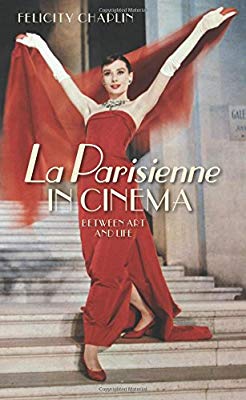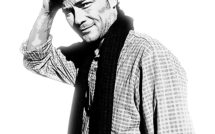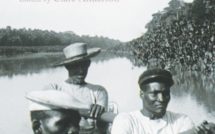
 Any study of as broad a corpus as is indicated by this book’s title is likely to have multiple aims, and Felicity Chaplin’s book seems to set itself not just the objective of adding cinema to the list of art forms in which La Parisienne frequently figures and has been studied (painting and drawing), but of using a typically art historical methodology (iconography) to do so.
Any study of as broad a corpus as is indicated by this book’s title is likely to have multiple aims, and Felicity Chaplin’s book seems to set itself not just the objective of adding cinema to the list of art forms in which La Parisienne frequently figures and has been studied (painting and drawing), but of using a typically art historical methodology (iconography) to do so.
Chaplin explains in her introduction that Erwin Panofsky’s theory of iconography has already been applied to cinema, particularly by Stanley Cavell and Jean-Loup Bourget, who “have both challenged Panofsky’s claim that sound cinema effectively abolished the need for typology” (8), but also by film critics such as Laurence Alloway in the journal Movie in 1963, and more recently Ed Buscombe. Approving of Alloway’s anti-evaluative and implicitly anti-auteurist idea of culture as a continuum, Chaplin introduces her corpus as one that ranges across this continuum, “from celebrated masterpieces by auteurs like Carné and Godard, to more ‘lightweight’ films like Jules Dassin’s Reunion in France (1942)…and lesser-known French romantic comedies such as Yvan Attal’s Ma Femme est une actrice (2001)” (11-12). Her study aims to “[establish] the Parisienne as a type in cinema through developing an iconography of the Parisienne type based on the recognition of various motifs” (14), and she emphasizes the difference between a stereotype, which la Parisienne is not – she is not “white, middle class, European” (14) – and “a type in the iconographical sense; that is, recognisable through certain recurring motifs, yet also constantly being reinvented” (14). The chapters that follow, “Muse,” “Cosmopolite,” “Icon of fashion,” “Femme fatale,” “Courtesan,” and “Star,” will build up an iconography of the Parisienne while simultaneously recognizing the impossibility of “damming the flow” [of representations] “with definitive statements” (15), and Chaplin ends her introduction with predictable caveats about making “no claim to exhaustiveness in coverage of the field…nor…a comprehensive portrait or visual history of la Parisienne in cinema” (17). Her selection of primarily French and American films is justified by the fact that these are the national cinemas in which the Parisienne is most often found, and she convincingly emphasizes the importance in the Parisienne’s development of “the transatlantic cultural exchange between French and American cinema in the 1950s and 1960s” (16), of which a prime example is Minnelli’s An American in Paris (1951), the film with which her discussion of the difficulty of defining the figure began.
The first three chapters proper of the book offer rich descriptions of the Parisienne characters in Renoir’s Elena et les hommes (1956), Raúl Ruiz’s Klimt (2006) and Woody Allen’s Midnight in Paris (2011) (in “Muse”); Duvivier’s Pépé le Moko (1937), Jacques Demy’s Model Shop (1969), and Billy Wilder’s Sabrina (1954) (in “Cosmopolite”); then Dassin’s Reunion in France (1942), Stanley Donen’s Funny Face (1956), Minnelli’s Gigi (1958), Polanski’s Frantic (1988) and François Ozon’s 8 femmes (2001) (in “Icon of fashion”). These chapters’ presentations of the dimension of the Parisienne type at issue (“Muse,” “Cosmopolite,” “Icon of fashion”) are entirely convincing, although the elasticity claimed for the Parisienne in the existing writings on which Chaplin draws does often seem remarkable – “Thus la Parisienne is a figure whose national particularity was always already international or global at its conception” (Louis Uzanne in 1910, 48), or “The inability to categorise or fix la Parisienne in terms of nationality or class contributes, in part, to her mystery and her possession of a certain ontological je ne sais quoi” (56). This changes in the fourth, “Femme fatale” chapter, where Chaplin seems to be seeking to merge the profile of the Parisienne she is developing with the already highly familiar cinematic notion of the femme fatale, analyzed here in French rather than Hollywood film noir (poetic realist and Marcel Carné classics Le Quai des brumes (1938) and Le Jour se lève (1939), Jules Dassin’s Du Rififi chez les hommes (1955), and Godard’s A bout de souffle, which does have strong noir elements despite also being so much besides). Although Chaplin succeeds in arguing that the femme fatale in French film is different from her American counterpart, in that she brings about men’s downfall unintentionally rather than intentionally, the claim that this is because “she is the embodiment of the nineteenth century French tradition which associates women and the city with death, an association continued in the primarily urban settings of film noir” (96) pulls the type back towards pre- and extra-cinematic contexts (Baudelaire, Théophile Gautier) that definitely predate the invention of the term femme fatale “around 1912” (98). Chaplin seems to realize at the end of the chapter that its readings have expanded possible readings of the femme fatale more than they have added to her descriptions of the Parisienne as she is found in cinema when she says “By drawing the figure of la Parisienne into the context of French film noir, different readings of the femme fatale become possible” (118). A little of the same muddying of the Parisienne as type occurs in the following, “Courtesan” chapter, although the discussions here of Chaplin’s silent film A Woman of Paris (1923), Alain Cavalier’s La Chamade (1968) and Baz Luhrmann’s Moulin Rouge! (2001) draw on the iconography of la Parisienne as courtesan established in nineteenth-century French literature (the plot of Moulin Rouge! draws on Puccini’s La Bohème or its literary source material) without tending to blur the two categories. The final, “Star” chapter offers commentaries on Michel Boisrond’s Une Parisienne (1957), Claude Berri’s L’un reste, l’autre part (2004), Godard’s Une femme est une femme (1961) and Louis Malle’s Les Amants (1958), drawing on the work of Ginette Vincendeau to articulate the “Parisienne iconographical profile” of Brigitte Bardot, Charlotte Gainsbourg, Anna Karina, and Jeanne Moreau in these films. The star personas of all these actors except Gainsbourg have already been studied (Karina’s, which is largely confined to the films of Godard, less than Bardot or Moreau), and Chaplin includes an absorbing and highly convincing initial study of Gainsbourg as the bobo (bourgeois bohème) star par excellence in the chapter.
Throughout her book, Chaplin readily acknowledges that la Parisienne is in many ways particularly a nineteenth-century figure, at her strongest in the Second Empire Paris of Haussman and during the early Belle Époque. It may therefore not be surprising that it is in the more contemporary films discussed – Ozon’s 8 Femmes and Berri’s L’un reste, l’autre part from 2001 and 2004, though not Ruiz’s Klimt (2006) and Allen’s Midnight in Paris (2011), which find their Parisienne in earlier period of history – that her iconographical method is under the most strain: she rightly points out that “[b]y the time of Gainsbourg’s emergence as a star, stardom had already begun to cross the threshold to celebrity” (177), and only just manages to persuade herself and us that 8 Femmes “provides yet another cinematic figuration of la Parisienne” (90) in Louise (Emmanuelle Béart) and Augustine (Isabelle Huppert), so subversive is the film’s aestheticism (which is entirely of its time, despite the film’s setting in a 1950s environment). Chaplin’s book succeeds entirely in its aim to add cinematic representations to the art forms in which the Parisienne originated, and illustrates fascinatingly a range of the different incarnations the figure has had across twentieth century French and American cinema, so it is a little disappointing that she does not incorporate any historical reflections into the “provisional definition” of the Parisienne offered in her conclusion: “a type of which atypicality is the dominant feature; a type whose identity is continuously displaced or deferred, simultaneously reaching back to her earliest manifestations in the nineteenth century and forward to future manifestations which will both affirm and rework the iconography of the type” (182-3). This is too poststructuralist a definition to deal satisfactorily with postmodern and post-postmodern cultural history: achieving the goal of “[going] some way towards constructing what might be called a cycle of Parisienne films” (183) is sufficient, without trying to insist that the cycle “is never complete, but is continuously evolving” (183), which means that la Parisienne cannot be a type in the usual iconographical sense. Chaplin actually acknowledges this in her previous paragraph when she says that a type’s self-identity “forms the basis of the recognition necessary for iconography” (183), but that ‘la Parisienne…is that type which, in Houssaye’s words, “never resembles herself,” whose typology and thus iconography is always in question” (183), without commenting at all on how this claim undermines the methodology she has employed so fruitfully throughout her study. Despite these flaws in argumentation, Chaplin’s book certainly does extensive impressive groundwork for further studies of the Parisienne figure in cinema, which might for example take in a broader range of national cinemas or employ different methodological approaches.
Reviewed by Kate Ince, University of Birmingham
La Parisienne in Cinema: Between Art and Life
By Felicity Chaplin
Publisher: Manchester University Press
Hardcover / 216 pages / 2017
ISBN: 978-1-5261-0955-2
Published on November 8, 2018.
To read more reviews click here.




